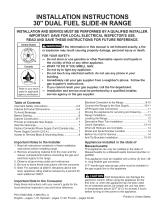
2
30" DUAL FUEL SLIDE-IN RANGE INSTALLATION INSTRUCTIONS
(Models with an Electric Oven and a Gas Cooktop)
Installation of this range must conform with local codes
or, in the absence of local codes, with the National Fuel
Gas Code ANSI Z223.1/NFPA54 or CAN/ACG-B149.1
and CAN/ACG-B149.2.
This range has been design certied by CSA
international. As with any appliance using gas and
generating heat, there are certain safety precautions
you should follow. You will nd them in the Use and
Care Guide, read it carefully.
• Air curtain or other overhead hoods, which operate
by blowing a downward air ow on to a range, shall
not be used in conjunction with gas ranges other
than when the hood and range have been designed,
tested and listen by an independent test laboratory
for use in combination with each other.
• Be sure your range is installed and grounded
properly by a qualied installer or service
technician.
• This range must be electrically grounded in
accordance with local codes or, in their absence,
with the National Electrical Code ANSI/NFPA No.
70—latest edition in United States or with CSA
Standard C22.1, Canadian Electrical Code, Part 1
in Canada.
• The installation of appliances designed for
manufactured (mobile) home installation must
conform with Manufactured Home Construction and
Safety Standard, title 24CFR, part 3280 [Formerly
the Federal Standard for Mobile Home Construction
and Safety, title 24, HUD (part 280)] or when
such standard is not applicable, the Standard for
Manufactured Home Installation 1982 (Manufactured
Home Sites, Communities and Setups), ANSI
Z225.1/NFPA 501A-latest edition, or with local codes
in United States and with CAN/CSA-Z240 MH in
Canada.
• Make sure the wall coverings around the range
can withstand the heat generated by the range.
• Before installing the range in an area covered
with linoleum or any other synthetic oor
covering, make sure the oor covering can
withstand heat at least 90°F above room
temperature without shrinking, warping or
discoloring. Do not install the range over carpeting
unless you place an insulating pad or sheet of ¼"
(0,6 cm) thick plywood between the range and
carpeting.
• Do not obstruct the ow of combustion air at
the oven vent nor around the base or beneath
the lower front panel of the range. Avoid touching
the vent openings or nearby surfaces as they
may become hot while the oven is in operation.
This range requires fresh air for proper burner
combustion.
Never leave children alone or
unattended in the area where an appliance is in
use. As children grow, teach them the proper, safe
use of all appliances. Never leave the oven door open
when the range is unattended.
Stepping, leaning or sitting on the
doors or drawers of this range can result in serious
injuries and can also cause damage to the range.
• Do not store items of interest to children in
the cabinets above the range. Children could be
seriously burned climbing on the range to reach
items.
• To eliminate the need to reach over the surface
burners, cabinet storage space above the
burners should be avoided.
• Adjust surface burner ame size so it does not
extend beyond the edge of the cooking utensil.
Excessive ame is hazardous.
A child or adult can tip the range and •
be killed.
Verify the anti-tip device has been •
installed to oor or wall as per
installation instructions.
Tip Over Hazard
Ensure the anti-tip device is re-engaged to oor or •
wall when the range is moved.
Do not operate the range without the anti-tip device •
in place and engaged.
Failure to follow these instructions can result in •
death or serious burns to children and adults.
To check if the anti-tip bracket is installed
properly, use both arms and grasp
the rear edge of range back. Carefully
attempt to tilt range forward. When
properly installed, the range should not
tilt forward.
Refer to the anti-tip bracket installation instructions
supplied with your range for proper installation.
This manual contains important safety symbols and instructions. Please pay attention to these symbols and
follow all instructions given.
This symbol will help alert you to situations that may cause serious bodily harm, death or
property damage.
This symbol will help alert you to situations that may cause bodily injury or property
damage.
IMPORTANT SAFETY INSTRUCTIONS
















